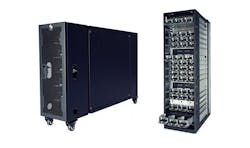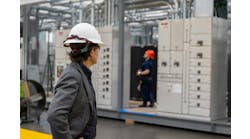EDJX Edge Network Integrates Sustainability, Software-Defined Power
Edge computing creates the opportunity for new approaches to IT challenges. One of the startups applying new ideas and technology is EDJX, which is building an intelligent network to support “serverless” computing along with established edge uses like content delivery and DNS routing. The company recently announced new funding and the launch of three network nodes in data centers operated by Cyxtera.
The EDJX delivery platform offers several form factors for placing distributed edge servers in offices and stores, ranging from micro servers the size of a credit card to full racks of Open Compute hardware. It enters the data center sector using hardware from ITRenew that is repurposed from hyperscale operators, and integrating a software-defined power solution from Virtual Power Systems (VPS) that brings new efficiencies to power management.
EDJX CEO John Cowan says it expects to “dramatically lower the cost of edge computing while delivering at planet-scale and giving developers complete freedom and control with no lock-in.” Cowan was previously CEO of 6fusion, which led the initial $2 million funding round for EDJX. In October, the company announced $3 million in new funding from VCapital. The EDJX board includes industry veterans Joe Weinman (author of Cloudonomics) and Dean Nelson (Uber, VPS).
“Our ambition is to build the world’s largest private network,” said James Thomason, the Chief Technical Officer of EDJX and veteran of startups Hypergrid and Gale Technologies. ” I want a network that spans millions of edge nodes.
“When we look at the raw computing capacity and storage capacity needed (for the future edge), it’s an astronomical figure,” said Thomason. “We realized that the edge wasn’t going to come anytime soon unless we could figure out a different kind of supply chain. Also, with that kind of infrastructure investment, the scale of the waste and harm we could be doing to the world is pretty unimaginable.”
Partnerships With ITRenew, VPS
That’s why EDJX has developed edge infrastructure for a “circular economy” that reuses and recycles IT equipment and operates with a small energy footprint. ITRenew and VPS are key partners in this effort. The EdjBlock systems deployed at Cyxtera and other locations will feature hardware from Sesame by ITRenew and integrate the ICE (Intelligent Control of Energy) system from VPS.
ITRenew specializes in decommissioning data centers and recycling IT hardware assets. Some of their largest customers are hardware operators that refresh their servers frequently, and retire equipment that can be reused. IT Renew removes the data from this equipment and repurposes it through its Sesame line of rack-scale solutions built on open architectures.
An overview of IT Renew’s “circular data center” ecosystem. (Image: IT Renew)
“One thing about the hyperscalers is they’re throwing off gear that the rest of us consider pretty new,” said Thomason. “It enables us to build up this massive capacity at the edge, without destroying the planet in the process and in a price point that is quite frankly unbeatable.”
“Sustainable data center models, implemented in the right way, can accelerate growth and deliver significantly better edge computing economics,” said Ali Fenn, President of ITRenew. “Together with EDJX, we have the opportunity and the imperative to make turn-key edge infrastructure solutions broadly available.”
Virtual Power Systems is a startup that offers software, hardware appliances and lithium-ion batteries to optimize power distribution within a data center. As with server virtualization, software-defined power offers the promise of bringing new levels of efficiency and automation to data centers. That includes reallocating power from underused racks to IT gear that needs additional power.
VPS uses a combination of software and distributed batteries to conduct peak shaving, using the batteries to store power and allocate it to the system when needed, creating a more elastic system for distributing power.
“Most data centers basically are provisioned with double (energy) capacity right because they have to be able to tolerate some failure in the grid,” said Thomason. “There’s untapped capacity sitting in the data center, but today they don’t dare provision it right because if they do, they would be constrained in a power failure scenario. The VPS technology gives us software control so we can go into a data center and we can sit in their excess capacity. When a power failure occurs, the VPS hardware will allow us to coast on the ride-through, cleanly shut down and return the capacity to the data center before their UPS ride through is exhausted.”
“The most sustainable data center is one that is never built,” said Dean Nelson, the CEO of VPS. “We all want every click to improve the future. By partnering with EDJX and ITRenew we are not only realigning the IT supply chain toward inherent environmental sustainability, we are enabling existing data centers to increase the utilization of the power they have already built.”
Cyxtera is First Data Center Partner
The EDJX EdjBlock rack system is being deployed in Cyxtera data centers in Santa Clara, Dallas and Weehawken, N.J.
“Cyxtera is becoming points of presence on the EDJX network, where data is stored but also served to edge customers,” said James Thomason, Chief Technical Officer at EDJX. “In the San Francisco region we have several retail and office locations that are on our network with an EdjBlock Micro with five servers in a rack with some last mile connectivity. Cyxtera is in its Santa Clara data center.
“Those nodes are all federated into the same platform, and the network will coordinate and send people to the closest edge location to them, where they can experience lower latency and higher bandwidth,” said Thomason. “The network nodes all maintain information like the network maintains state – how the nodes are doing and what capacity they have and latency. We have a geographic geo-routing system that will approximate a user’s location and try to get them an edge node as close as possible.”
“Cyxtera is focused on delivering the diversity of innovative infrastructure solutions that meet the demands of today’s enterprise customers,” said Holland Barry, Senior Vice President and Field CTO, Cyxtera. “We see tremendous potential in rolling out a truly global edge computing platform in our data centers in partnership with EDJX.”
Video as a Sensor, Serverless Use Cases
One of the edge use cases EDJX is seeing in its early installations is “video as a sensor” to detect remote environments. “What the market wants is smart insights from visual sensors,” said Thomason. “The way the industry is approaching that is by trying to pack more and more computing onto the camera. At a certain point, your camera becomes so powerful, it’s a computer and it’s as expensive as something that goes in your data center.
“But for simply capturing video data, the cameras themselves are incredibly cheap,” he said. “If you flip the architecture around where the camera is dumb, but there’s smart, powerful computing somewhere nearby, the economics become a lot more tenable.”
EDJX is among the edge computing players targeting the market for serverless architectures, a developer-friendly trend which abstracts the hardware and can run smaller chunks of code than typical applications. Others targeting this niche include initiatives from content delivery networks, such as Cloudflare Workers and Limelight’s EdgeFunctions.






